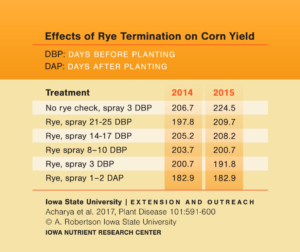Menu
Timing Your Burndown Program to Maximize yield
Cover Crop Burndown and Maximizing Yield
The use of cover crops and their value has increased over the past number of years. However, many questions come up about how and when is the best time to burn down those cover crops. There has been some adoption of planting green into more mature cereals, and the results of that have been mixed based on the growing season, rainfall amounts and other environmental factors.
With spring just around the corner, I want to focus today more on the timing of burndown, to maximize yields. There has been ongoing research at Iowa State University from 2009-2018, that I will reference, because it mimics what we have seen in the fields in recent years.
There are many benefits to cereal crops used as cover crops, however we have noticed some things that can help us better utilize these cover crops and still maximize yields.
The first thing that I want to address is the fact that the timing of burndown, can have in impact on yield.
Burndown Timing and Seedling Diseases
The potential for yield loss exists due to various factors. One contributing factor is the timing of burndown, and the decaying cover crops can increase the potential for seedling diseases, especially fusarium and pythium species. Research has shown that winter rye can be a host crop of these pathogens, increasing the potential for corn seedling diseases.
We all know seed treatments can help a great deal in managing seedling disease, but there are significant differences in the level of control from the various seed treatment options seed companies use.
In the Iowa State trials, the closer to planting you terminated the cereal rye, the greater the incidence of seedling disease pressure.
We all know if we have seedling disease pressure, it can affect the timing of seedling emergence and the uniformity of the seedling emergence.
Below is a chart that shows corn yields based on termination of the cover crop from 21+ days before planting, to 1-2 days after planting. As you will see in the data, terminating the cover crop earlier consistently gives you a greater opportunity to maximize yields.
Early Termination Can Improve Yields Significantly

My recommendation has always been to try and terminate the cereal crop 14+ days before planting, and I think the Iowa State data confirms the advantage of that timeline. Another benefit of early termination is the cover crop has enough time to decompose to the point it is brittle and much easier to plant through.
Earlier termination also can make the cereal crop easier to kill. Once cereal crops get beyond feekes 6-7, they can be more challenging to control with paraquat. However, we know that adding a triazine to a paraquat application can enhance the efficacy of the product. Glyphosate does a good job on cereals, but under cooler conditions it can be a very slow kill.
Tank Mix Options
Remember when putting your tank mix together to choose the right adjuvant for the situation. With glyphosate you want to add AMS or a water conditioner like Turbo or Vaporize. However, If you add Kixor® herbicide to glyphosate, do not use a water conditioner that acidifies the tank mix, or it will reduce the efficacy of Kixor®. With paraquat, the use of Spreader 820 or another non-ionic surfactant is recommended. (Kixor® is a registered trademark of BASF.)
At PowerAG our customer service team is always ready to assist you in any of these decisions, so feel free to contact us if you have any questions.


